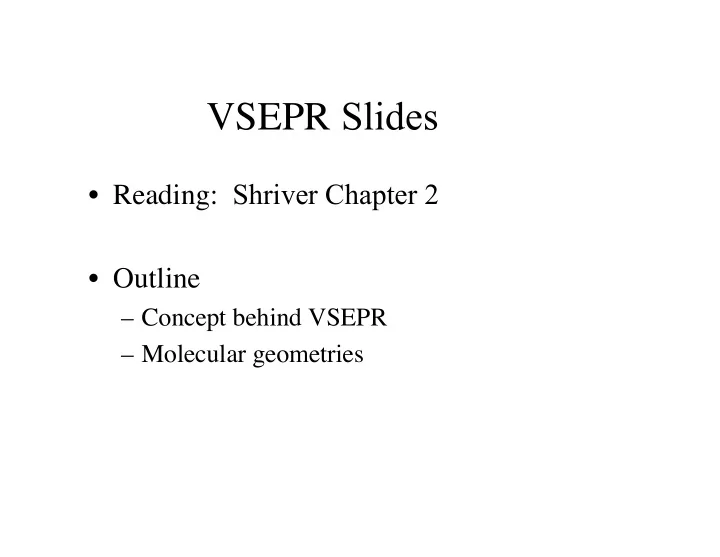

VSEPR Slides • Reading: Shriver Chapter 2 • Outline – Concept behind VSEPR – Molecular geometries
VSEPR Background • The Lewis Dot Structure approach provided some insight into molecular structure in terms of bonding, but what about geometry? • Recall from last lecture that we had two types of electron pairs: bonding and lone. • Valence Shell Electron Pair Repulsion (VSEPR). 3D structure is determined by minimizing repulsion of electron pairs.
VSEPR Background (cont.) • Must consider both bonding and lone pairs in minimizing repulsion. • Example: CH 4 H H C H H Lewis Structure VSEPR Structure
VSEPR Background (cont.) • Example: NH 3 (both bonding and lone pairs). H H N H Lewis Structure VSEPR Structure
VSEPR Applications • The previous examples illustrate the strategy for applying VSEPR to predict molecular structure: 1. Construct the Lewis Dot Structure 2. Arranging bonding/lone electron pairs in space such that repulsion is minimized.
VSEPR Applications • Linear Structures: angle between bonds is 180° • Example: BeF 2 F Be F F Be F 180°
VSEPR Applications • Trigonal Planar Structures: angle between bonds is 120° • Example: BF 3 120° F F F B F F B F
VSEPR Background (cont.) • Pyramidal: Bond angles are <120°, and structure is nonplanar: • Example: NH 3 H H N H 107°
VSEPR Applications • Tetrahedral: angle between bonds is ~109.5° • Example: CH 4 H 109.5° H C H H
VSEPR Applications • Tetrahedral: angle may vary from 109.5° exactly due to size differences between bonding and lone pair electron densities bonding pair lone pair
VSEPR Applications • Classic example of tetrahedral angle shift from 109.5° is water:
VSEPR Applications • Comparison of CH 4 , NH 3 , and H 2 O:
VSEPR Applications • Trigonal Bipyramidal, 120° in plane, and two orbitals at 90° to plane: • Example, PCl 5 : Cl 90° Cl Cl P 120° Cl Cl
VSEPR Applications • Octahedral: all angles are 90°: • Example, PCl 6 : Cl Cl Cl P 90° Cl Cl Cl
Advanced VSEPR Applications • Square Planar versus “See Saw” See Saw No dipole moment Square Planar
Advanced VSEPR Applications • Driving force for last structure was to maximize the angular separation of the lone pairs.
Advanced VSEPR Applications • VSEPR and resonance structures. Must look at VSEPR structures for all resonance species to predict molecular properties. O O O O O O O
VSEPR Applications • Provide the Lewis dot and VSEPR structures for CF 2 Cl 2 . Does it have a dipole moment? F F C Cl F 32 e - F Cl Cl Cl Tetrahedral
Recommend
More recommend